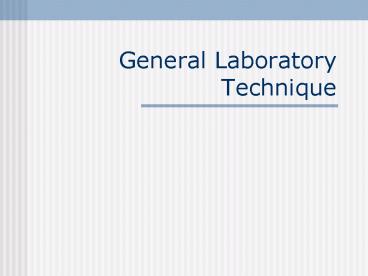General Laboratory Technique PowerPoint PPT Presentation
1 / 54
Title: General Laboratory Technique
1
General Laboratory Technique
2
Common Apparatus / Equipment
3
Common Apparatus / Equipment
4
Test tube and Boiling tube
5
Test tube holder
6
Round-bottomed flask and Flat-bottomed flask
Stronger than the flat-bottomed flask but
clamping is required. Usually used in generating
gas.
Round-bottomed flask
Flat-bottomed flask
7
Spatula
- Spoon used in the laboratory.
8
Electronic balance
Dont add anything into a weighing bottle over
the pan of the balance. Chemicals may fall onto
the pan.
9
Electronic balance
x
Dont add anything into a weighing bottle over
the pan of the balance. Chemicals may fall onto
the pan.
10
Heat resistant mat /Fireproof mat
All hot objects MUST be placed on the heat
resistant mat to protect the bench. Especially,
the newly extinguished matches before they are
disposed of.
11
Heat resistant mat /Fireproof mat
Put the used matches on the heat resistant mat to
allow them to cool down.
?
X
12
Stand and Clamp
For the apparatus that would be subjected to
heating should only be clamped loosely. A little
space should be allowed for the glassware to
expand otherwise it may crack.
13
Stand and Clamp
Wrong
Right
The mouth of the clamp should be opening upward,
otherwise the clamp may drop if the clamping is
loose.
14
Stand andPlastic burette clamp
Adjusting the position
15
Common Laboratory Technique
16
Operation of Bunsen burner
17
Operation of Bunsen burner
18
Operation of Bunsen burner
- Only a non-luminous flame should be used to heat
glassware. A yellow flame contains unburnt carbon
particles which will blacken glasswares. - The used match should be place on the heat
resistant mat until it is completely extinguished
19
Operation of Bunsen burner
Why should the air hole be closed before a burner
is lighted up ?
20
Press and turn the knot to turn on the gas supply
21
Handling of striking back
22
Handling of striking back
- Turn off the gas supply immediately.
- Wait, Wait, Wait, Wait and Wait
- After the collar has cooled down, close the air
hole and light the burner again.
23
Transferring chemical
24
Take your apparatus to the chemcial
25
Dont take the chemical back to your seat.
26
Transferring of solid
Use the smaller end of a spatula only. The larger
end is only for the laboratory technician to
transfer a large amount of chemical. A small
spatula measure of solid weighs about 0.2 to 1
gram, depending on the solid.
27
Transferring of solid
Any excess chemical from the reagent bottle
should not be returned to the reagent bottle
otherwise the reagent will be contaminated (get
dirty) NOR putting onto the bench. Put the excess
chemical into the Waste Beaker on the bench, if
you do not see the beaker, ask your teacher or
the laboratory technician.
Waste Beaker
28
Transferring of solid
Waste Beaker
29
Transferring of solid
Be Carefully ! Try not to drop any chemical onto
the bench.
30
Transferring of liquid
31
Transferring of liquid
32
Mixing solution
33
(No Transcript)
34
Heating technique
35
Heating hydrated solid
The tube should be pointed downward otherwise the
condensed water may crack the bottom due to local
contraction of glass.
36
Heating solution in a test tube
Test tube is not for boiling liquid. For every 5
seconds of heating, the tube should be swirled
away from the flame for at least 5 seconds.
37
Heating flammable liquid
38
Heating flammable liquid
39
Heating flammable liquid- no naked flame (????)
40
How much water is enough in a steam bath ?
41
Problem of using too less water.
42
Collection of gas
43
Displacement of water
44
Delivery of gas / Displacement of air
45
Gas syringe
46
Prevention of sucking back
47
Drying substances
48
Desiccator
49
Desiccator
50
Common Drying agentse.g. anhydrous calcium
chloride
51
Common Drying agentse.g. anhydrous calcium oxide
(??)
52
Common Drying agentse.g. silica gel (???)
53
Washing bottle
54
U-tube

